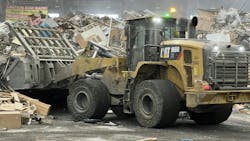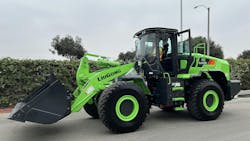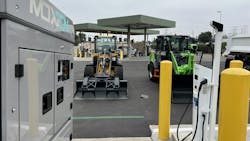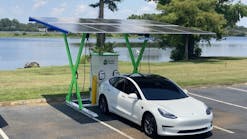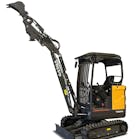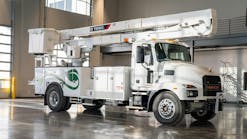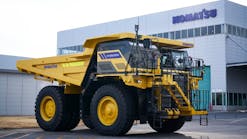David Bolderoff, CEM, fleet manager for the Sanitation Districts of Los Angeles County, the Construction Equipment and AEMP 2024 Fleet Masters award winner for large fleets (over $100 million ERV), was an early adopter of alternative power, running Cat D7E hybrid diesel electric dozers in the Districts’ transfer stations back in 2015.
Flash forward to 2024, just nine years later, to find some amazing numbers.
- Twenty-two percent of the Districts’ 1,100 on- and off-road assets now run on electric power.
- Ten battery-electric machines are in the fleet, including eight compact and mid-sized wheel loaders.
- The fleet has 135 plug-in electric vehicles, including 12 medium-duty and five heavy-duty trucks.
- Three towable battery-electric storage systems (BESS) provide mobile power, and 124 charging stations are at District facilities with another 350 more coming within five years.
The numbers achieved are the result of careful research, telematics data, and partnerships with dealers and manufacturers.
“When venturing into new technology like plug-in battery electric equipment where historical information is lacking, we collaborate with manufacturers to secure additional extended warranty coverage on components like battery packs,” Bolderoff says. “This approach mitigates our risk of unexpected repairs, component replacements, and associated costs. It effectively shares the risk with our manufacturer partners.”
Demand is there for electrification of equipment
In addition to securing extra protection, Bolderoff tells OEMs what he wants. After presenting at an Association of Equipment Manufacturers meeting late in 2022 with another industry colleague, Bolderoff sensed manufacturers in general had a reluctance to go deeper into the electrification realm.
“We threw it out to them, ‘We want electrification products now,’ because there was a general vibe of ‘Sure, we can build it, but no one wants them, so we’re going to wait,’” Bolderoff recounts. “That was the general consensus in the room, and I and Ken Burke from Bechtel got up there and said, ‘No, we want these things and we want them now.’”
Enter an unlikely source. “At that stage, the president of LiuGong North America approached me and said, ‘We are bringing our first machine in; it sounds like you guys want something.’ I’d never dealt with them—with any new manufacturer, you’ve got to walk in there and do your due diligence.
“I found that LiuGong has been building wheel loaders for 60 years,” Bolderoff says. “This isn’t a new startup. They have that history, and then they also have 1,000 electric wheel loaders operating, mostly in China but in other countries as well.”
The units the Sanitation Districts were seeking were not the compacts where the more familiar OEMs have chosen to explore the market. These are 48,000-pound loaders with 4.5-cubic-yard bucket capacities.
“They were the first to market, the only ones who had a machine that size,” Bolderoff says. “We purchased the first one in the country in 2023 and because of the success of that first one, we ordered another three.
Telematics begets electrics
Having used telematics since 2009, Bolderoff has extended his use of the data to identify opportunities for electrification and alternate power.
“You have to look at the hours per day you’re operating and then look at fuel burn as well, trying to equate that to kilowatt-hours (kWh) energy consumption,” Bolderoff says. “That’s critical to understand what size battery pack you need. On the on-road side, the biggest problem with adoption of EVs is range anxiety.
“Everyone says, ‘I can’t do [electric] because I have to do this,’ and everyone would state the worst-case possibility,” Bolderoff says. “‘Once a year I drive out 300 miles to this one location and I have to do it. It’s critical to my job.’”
This is where Bolderoff recommends a 95% scenario, as in “Can we get 95% of the job done and deal with the rest later?”
“How can you use an alternative vehicle or maybe use public infrastructure for recharging?” he says. “By having that telematics data, you can actually see profiles per day, per week, per month, how many miles they’re actually doing—not what someone thinks they’re doing.
“That perception of what they need to do compared to what the data is saying can be two different things,” he says. “And by having that data and sitting down with these user groups and saying, ‘You say you’re doing this, but the data shows this,’ it’s powerful.”
Here is where the problem solving comes in. Bolderoff suggests asking questions. Are there opportunities to stop and charge along the route? Perhaps while a truck is being loaded, or at lunch? Are trucks carrying too much weight? Are there extra tools and equipment reducing range?
“Having that telematics data is the key to really understanding how to build the trucks or equipment of the future,” Bolderoff says.
The Districts have done a lot to make charging an easy task. There are chargers available all over its facilities, with plans to add 450 more in five years. It has also purchased three Moxion towable battery electric storage systems (BESS) for mobile charging needs.
“It’s trailerable battery with 75 kilowatts of power and 600-kWh of battery energy storage in there,” Bolderoff says. “We’re using them as temporary EV charging so you can charge multiple vehicles at once. You can even expand that out, too, and have 10 EV chargers operating off one BESS.
“They are also able to provide backup power to a facility during outages to keep our customers flowing through our facility,” Bolderoff says. “This could be the future of mobile recharging. Moxion seems to be the biggest system out there, but it does weigh 12,000 pounds so you need a CDL for transport. Once you’ve depleted that 600 kWh, you take them to an EV charging station to recharge the trailer itself.”
Grant funding covered 90% of the purchase price for these mobile batteries through collaboration with the manufacturer, according to Bolderoff.
“An OEM and dealer worked with the state to get the equipment approved for grants, and get credits sent directly to them—you pay the net after that,” Bolderoff says. “We don’t have to expend large funds up front and wait for reimbursement. We encourage OEMs to get registered.”
So far, such savings have resulted in $4 million of grant funding and incentives for EVs. Bolderoff tracks it all.
Read more about David Bolderoff as a young leader
“We’re seeing total cost of ownership less than diesel for these types of equipment,” he says. “We’re still not 100% sure what the maintenance cost is, but the fuel cost is significantly cheaper using electric, and we’re seeing grants and rebates at both the federal and state level, so we’re getting these costs of new equipment and vehicles on par with diesel machines.”
Dethroning diesel
Bolderoff has long been a proponent for alternative power to reduce diesel fuel usage. “We’re doing everything we can to reduce diesel fuel consumption, and any of that consumption you can’t avoid, we’re using diesel renewables,” he says.
The entire off-road heavy equipment fleet has transitioned to renewable diesel, a transition that started in 2018. It has resulted in a 65% reduction in the carbon footprint of that equipment.
“As a fleet, we’re 70% renewables, which includes renewable diesel, renewable natural gas, and renewable electricity, so we’re trying to solve that last 30%, which is usually gasoline,” Bolderoff says. “That’s what’s left. With the light- or medium-duty vehicles, we’re looking to go from gasoline to electric.”
The fleet already has electric F-150 Lightnings, Chevy Bolts, Tesla Model 3s, and Ford E-Transits.
On the heavy on-road side, the fleet has added five Kenworth T680 battery electric trucks that Kenworth says have 150-mile ranges. But there’s the issue of adding weight.
“We’re putting them in vocational applications, including one with a dump body and another with a water tank,” Bolderoff says. “There’s also a semi-truck configuration hauling a transfer trailer at 82,000 pounds, so we’re having an electric PTO installed on there because these trailers are self unloading. The E-PTO is basically taking energy from the propulsion battery to drive an electric motor and hydraulic pump.”
As usual, he is on top of the numbers. “We’re probably only going to see a 100-mile range out of this 400 kWh battery based on our driving profile,” Bolderoff says. “So we need 150 miles per day. We’re hauling three loads per day, each load being a 50-mile round trip. But a driver takes an hour lunchtime, so we need him to connect to a charger during that lunch break. We call that an ‘opportunity charge.’’’
Instead of going back to the manufacturer and saying they need a bigger battery to do the same amount of work, the fleet has figured out a solution by identifying unproductive times to do extra charging.
“It isn’t going to slow down their day, and it’s going to achieve the same result,” Bolderoff says. “You have to find the spaces where you can add energy. The diesel equivalent weighs in at 8 tons, CNG is 9 tons, and this is 12 tons, so we’re adding four tons of payload to the tare. That means four tons of material we can’t carry, so it’s harder to be cost effective.
“We need to figure out how to be more efficient so we can reduce that battery size and we’re not adding to the tare weight of these trucks,” Bolderoff says. “How small of a battery can we go to and still achieve the same level of production?”
